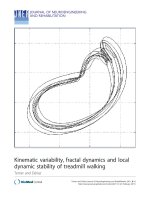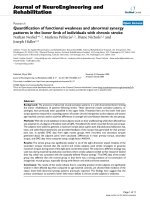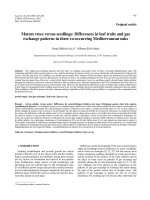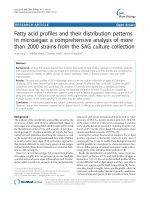Social dynamics and local trading patterns in bantaeng region, south sulawesi (indonesia) circa 17th century 6
Bạn đang xem bản rút gọn của tài liệu. Xem và tải ngay bản đầy đủ của tài liệu tại đây (8.42 MB, 62 trang )
296
Chapter 6
Understanding Dynamics of Life in Bantaeng Region
from Archaeological Excavation
1. Method of Archaeological Activity
Systematic archaeological excavation was carried out along the Binanga Tangnga-
Tangnga and Salo Biangkeke streams in 2000. Ethnohistorical data indicates that two poli-
ties developed in these two valleys. Sites excavated included both those in the coastal
lowlands and the uplands. Sites were chosen for excavation on the basis of surface finds and
information obtained from local residents (including looters)
1
after survey conducted using a
1
Three former looters — Bustamin Nyios, around 70 years old, Haji Doding
75 years old, and Karaeng Bancing 60 years old — agree with that data.
Interviewed, May 2000.
297
randomized method. Excavation was aimed at identifying changing land use patterns from
distribution of material culture, and to infer the sizes and functions of the sites.
The elite maintained their status by monopolizing resources and conducting ceremo-
nies, and when the elite died they ostentatiously had burial goods interred with them. This
must be assumed rather than hypothesized because it is difficult to confirm stratification
within elite groups from the quantity and quality of burial goods and to determine the extent
to which there was elite control over social valuables (Schortman and Urban 1996).
Archaeological excavation attempted to ascertain the distribution of burial goods in
the 17
th
century burial system in Bantaeng. By excavating sites in both uplands and low-
lands, it was hoped that any differences between the practices in the two areas might be
detected.
Archaeological excavation used the box system (1 X 1 meter or 2 X 2 meter) and 20
cm spits. Extension of the box system was feasible depending on the findings. Soil screening
was used to check for small artifacts. Every find in every spit was described, photographed,
and drawn. Human bones usually were found 80 cm to 90 cm below the soil surface;
excavation ceased in spit 5 or 6 (100 cm or 120 cm below surface).
2. Burial Activities in Bantaeng in Circa 17
th
During the fieldwork, the macucuk’s technique was tested. Other excavation sites
were chosen because of archaeological evidence found on the soil surface-both artifacts
and ecofacts. In Bantaeng city, only sites in Bissampole, Palantikang and Letta have been
excavated, as those sites are available and landowners gave permission for them to be
examined. In the hinterland area, archaeological test-pits have been conducted in Benteng
298
Batu Terang, Sinowa, Borong Toa, Borong Kapala, Lembang Gantarangkeke, and
Gantarangkeke. No archaeological excavation was done in Batu Ejaya because of insuffi-
cient time, while in Onto excavation was not done because fieldwork was conducted during
the Islamic month of Sya’ban, when Karaeng LoE’s ceremony was in preparation.
The excavations also checked the accuracy of the macucuk in identifying objects
under the soil surface. Archaeological excavation demonstrated that the macucuk tech-
nique is 90% accurate in recognizing the presence of imported ceramic underground. All of
the macucuk anomalies were checked archaeologically and the result showed that the anoma-
lies were imported ceramic shards, some associated with human bones and some not as the
land is disturbed by cultivation, looting activity and modern development.
In Bissampole area (Bantaeng city), excavation was conducted in an open field where
a regency mosque was to be built. Ex-looters (Karaeng Bancing, Bustamin Nyios, and
Doding) mentioned that they had looted the area near SMA Negeri 1 Bantaeng and the
PLN office. As the Bissampole area is densely populated and only this open field was
Figure 79: Pak Syamsu similarly shows how to
carry out the macucuk method at another
archaeological site, Bissampole, Bantaeng city.
Figure 78: Pak Safry demonstrates
the use of the macucuk in Benteng
Batu Terang, Bantaeng city.
299
available, archaeological excavation was conducted for three reasons: checking the accu-
racy of macucuk technique, checking the accuracy of the informants, and checking the
cultural deposit in this site before the location is altered by development.
From 12 boxes opened archaeologically in the PLN area and SMA Negeri 1 Bantaeng,
it can be inferred that these sites were burial areas circa 17
th
century. Human bones from six
individuals have been recorded in association with burial goods— imported ceramic shards
(dated between 16
th
-17
th
century), iron bangle, iron badik/dagger, iron knife, bronze small
bell, and bronze bracelets. However it was found that this area has been badly disturbed as
modern animal bones (chicken and buffalo), metal door slot, human bones, and imported
ceramic shards were found in different levels. Nevertheless, it can be concluded that the
human burials were located between 80 to 90 cm below the soil surface, oriented east west,
accompanied by burial goods.
300
The looting was both intensive and systematic, but they worked in a hurry to avoid
arrest. They often left holes or depressions which can help identify disturbed areas. In exca-
vating the Bissampole site in BSP/X-0/TP-6 an in-situ skeleton and the burial goods (iron
301
Figure 80: During excavation at BSP/X-
0/TP-6 discovered chicken bones,
fragment of bricks and door slot associ-
ated to human bones and imported
ceramics dated 16
th
-17
th
.
Figure 81: This box (BSP/X-0/TP-8) has
disturbed as fragment of imported ceramics
have found scattered associated to fragment
of human bones.
badik dagger and iron bangle) associated with it were found 80 cm below the soil surface,
but 40cm north of it there were human bones identified as being those of a baby boy aged
between one year to 18 months and metal artifacts (bronze bracelets and bells, and an iron
302
Figure 83: These metal artifacts were discovered at box BSP/X-0/TP-6 associated to
human bones.
Figure 82: Humerus (left and right) was discovered at 80 cm
under soil surface at Bisampole (Bantaeng city).
Figure 84: Box BSP/X-0/TP-6
303
304
knife), while at 30 cm beneath the surface there were scattered human bones identified as
those of an adult male aged between 25-35 years old associated with metal door slots, and
broken bricks. (Nayati 2000). These situations are also found in other test-pits within
Bantaeng region, which implies that this region is badly disturbed because of illegal looters.
Elsewhere, evidence of disturbed soil has been found in both coastal and hinterland
areas. In Letta (box LTT/X-0/TP-1) a plastic bag was found at 80 cm below the surface
with the name of a contemporary cracker snack producer from Surabaya in association
with imported ceramic dated to the 13
th
to 17
th
centuries. In Benteng Batu Terang a collec-
tion of chicken and cow bones, and the teeth of a cow were found associated with imported
ceramic dated 14
th
to 17
th
centuries.
Similary , excavations in Palantikang (Bantaeng city) and Gantarangkeke areas have
produced imported ceramic dated 13
th
to 18
th
centuries together with modern buildin
material. Moreover in Lembang Gantarangkeke, in boxes LGK/X-0/TP-1; LGK/X-0/TP-
2 and LGK/X-0/TP-4, there is evidence of soil disturbance: the land has been ploughed.
Similar conditions were found in Borong Kapala, Borong Toa, and Benteng Batu Terang.
These looting activities were conducted more than 30 years ago; it is difficult to find undis-
turbed areas in Bantaeng region where reliable archaeological checks can be carried out.
Compared to the Santa Ana site (Philippines) (Locsin 1967), Bantaeng burial finds
are limited; however finds were sufficient to prove that burial systems using burial goods had
been employed in the Bantaeng region. The Santa Ana site was 6,000 square meters and
intensively excavated archaeologically, while the Bissampole area is only 400 meters square
and only part was permitted to be excavated. Excavation time in Bissampole was limited to
just four days. Artifacts found in Santa Ana included many items (gold ornaments, clothing,
305
small jars, plates, and other items), which were not found in Bantaeng. Moreover, because
Bissampole in Bantaeng is densely populated, it is difficult to do further study concerning the
burial system. The finding of human bones in situ here is important as no data from an in-situ
burial had been recovered in this area previously. The differences between Santa Ana and
Bissampole (Bantaeng city) illustrate the contribution of population growth to the changes in
the archaeological record in the 1960s from that of 2000. Information about systematic
artifact looting from the 1960s to the 1990s can be used to predict the distribution of arti-
facts in adjacent areas—Selayar, Bulukumba, Jeneponto and Takalar.
The macucuk technique was 90% accurate in locating buried imported ceramic. This
technique uses a 150 cm metal rod (diameter 1 cm) with a wooden handle (see figure 11 and 12).
The macucuk operator pushes the rod into the soil; if the stick cannot be pushed further, the
macucuk can determine the reason: bedrock or imported ceramic. The macucuk operator only
applied the macucuk system in special types of soil, such as ladang sites near villages. It is
impossible to locate earthenware artifacts using macucuk, as the earthenware is too soft com-
pared to imported ceramic. The macucuk operators (Karaeng Bancing and Haji Doding) do not
want to share their secret—instead saying that they had dreamt about somebody leading them to
certain place. The macucuk operator is only experienced in locating imported ceramic as it is the
most valued type of goods. For the looters, the most important thing is to recognize the burial.
The burial is money as imported ceramic means cash. Other findings associated with imported
ceramic are extra money, as these items cannot be predicted by probing.
In Bantaeng fieldwork, the macucuk system was employed in ladang located outside
villages and in open spaces which were used to be ladang, and in villages which were used
as ladang before. Three boxes indicating imported ceramic based on macucuk were checked
306
archaeologically, and in all three boxes imported ceramic artifacts were found. Three other
boxes indicating no cultural deposit were opened archaeologically, and the result was con-
sistent with predictions. However, macucuk cannot identify whether the imported ceramic
is broken or in good condition.
Because of the accuracy of the macucuk technique, it was applied in other sites:
Lembang Gantarangkeke, Gantarangkeke, Sinowa, Borong Toa, and Benteng Batu Terang.
Lembang Gantarangkeke was chosen because there is an indication of stone arrangements
located north of the village with Ballaq Lompoa and Saukang. The stone arrangements
included different sizes and types of stones in ladang and cocoa plantations. Nevertheless
the best site with many types of stone arrangements at the ladang cannot be studied
archaeologically
2
so the archaeological excavation was conducted in a cocoa plantation and
in other ladang located north of the first site in order to investigate the stone arrangements.
Archaeological excavation was also conducted south of Ballaq Lompoa—near the south
stone fence in order to understand the different land use within Lembang Gantarangkeke.
Based on archaeological excavation it can be inferred that land use in Lembang Gantarangkeke
differed between the north and south location. Checking of the stone arrangement located in
north of village (LGK/X-0/TP-3) indicates that stone arrangements do not always repre-
sent human burials, as no indication of burial activity was found.
In LGK/X-0/TP-2 a cover of an imported ceramic covered box dated 14
th
century and
three imported ceramic shards dated 17
th
century interpreted as a bowl were found. In contrast,
it was found that the south part of the village had been used for daily activity, as potsherds
2
The land worker asked to be paid Rp. 1,000,000.00 per square meter (equal
to S$ 200.00).
307
interpreted as parts of vessels and jars, im-
ported ceramic interpreted as a jar dated 14
th
century, and part of an iron knife were found.
We were told that people found a balubu
(burial coffin) near the stone fence but this in-
formation is difficult to accept as the bedrock
in the south part of the village was found be-
tween 10 cm to 60 cm under soil surface.
One former looter (Karaeng Bancing) re-
ported discoveries of balubu made from logs
in several areas of Bantaeng, but he had for-
Figure 85: No human bones found at stone
arrangement. As shown at box LGK/X-0/
TP-3
308
gotten the details since the discoveries were made over 20 years earlier.
In Gantarangkeke, archaeological excavation was designed in order to investigate
land use. Systematic surface survey involved walking transects across dry fields by three
309
surveyors four meters apart. The survey recorded imported ceramic in the north part of
Gantarangkeke, and earthenware in the southern part of Gantarangkeke. No archaeologi-
cal remains were found around the Balla Lompoa Gantarangkeke. Excavation in the ladang
located northof the village yielded imported ceramic shards dated to the 16
th
and 17
th
cen-
turies in TP 1 and 2, while potsherds interpreted as jars and vessels were found at the
ladang south of the village (TP 3 and 4). It is possible that the vessels could be related to a
dwelling or to processions
to Passaungang Tauwa
which is located about 75
meters south of the exca-
vation box.
Excavation in
Sinowa was done in the
corner of a football field,
which was used as ladang.
Figure 87: Checking at south area of Lembang
Gantarangkeke. People informed that surrounding this box
has found Balubu. Excavation at Box LGK/X-0/TP-5 found
out that the soil in this area is maximum 60cm from surface.
Figure 86: A stone arrangement has been excavated at Lembang Gantarangkeke. We discovered
a lidded imported ceramic dated 14
th
century, but no indication of human bones.
310
311
Old local people informed us that this
place was used as a market during
the Netherlands Indies colonial pe-
riod. No artifacts were found in an
excavation, which reached 120 cm.
Test pits in Borong Toa based on
macucuk system revealed no human
bones but pottery shards, interpreted
as a bowl and plate dating from the 12
th
to 16
th
centuries.
At Benteng Batu Terang ar-
chaeological excavation was con-
ducted to investigate land use outside
the Benteng. There are stone arrange-
ments and pottery shards dating from
the 12th to 17
th
centuries. This
site was looted, and Syafri re-
membered that his father—
Habibu—mentioned that the
best imported ceramic in
Bantaeng had been found in
Benteng Batu Terang. Four
test pits found imported ce-
Figure 89: Potshards interpreted as parts of
vessels and jars discovered at ladang south of
Balla Lompoa Lembang Gantarangkeke.
Figure 90: Passaungang Tauwa, is located south of Balla
Lompoa Gantarangkeke
Figure 88: Excavation at south area of Lembang
Gantarangkeke—box LGK/X-0/TP-7.
312
313
ramic shards and buffalo bones. The shards included Chinese Ming Dynasty fragments of a
vase and a medium-sized bowl.
On the north side of the fortification there are stone arrangements at the Benteng Batu
Terang, which are interpreted as graves on account of the stone arrangements of stones
there. Imported ceramic found in these graves dated between the 14
th
and 18
th
centuries
(Nayati 2000b). However, local people did not give permission to excavate these, so these
anomalies have not been solved.
Scattered imported ceramics at the ladang near the graveyard are dated between
the 13
th
and 20
th
centuries with the majority from the 15
th
-17
th
centuries. Fieldwork in 1984
reported finding decorated earthenware and gold artifacts (a genital cover, a decorated
Figure 91: Findings from GK/X-0/TP-1
Figure 92: Findings from GK/X-0/TP-2
Figure 93: Part of stone arrangement found at north site of Benteng Batu Terang
314
lingga made from gold, and a gold mask) (Suaka Peninggalan Sejarah dan Purbakala 1984;
Bougas 1996). However, there is no further data on these artifacts at archaeological offices
in South Sulawesi Province (Makassar, Indonesia).
In Borong Kapala archaeological excavation was carried out in combination with
Doding’s looting system. Sites around Borong Kapala were studied by the
PUSLITARKENAS and Balai Arkeologi Makassar (Fatmawati 1997, Fadilah 1998, 1999)
Borong Kapala was chosen for further study, because according to local informants
this area had not been included in the previous research. An archaeological site is located 4
km north east of the village, and can only be reached on foot. Three test pits were opened
in which were found shards interpreted as vessels and jars, including between 3 and 5
vessels. Using Doding’s system 10 other test pits revealed similar potsherds. On the soil
surface, imported ceramic shards dated 14
th
century (interpreted as jars, bowls, and plates)
were recovered. Nearby a stone arrangement was archaeologically investigated but re-
vealed no indication of burial activity. Stone arrangements in Borong Kapala have a different
orientation, ranging from north south to east west. This anomaly differs from stone arrange-
ments in Benteng Batu Terang and Lembang Gantarangkeke.
Certain aspects of daily activity in the past in Bantaeng, such as using vessels to boil water,
can be inferred from the earthenware shards, although such activity cannot always be reliably
determined. Earthenwares have been found at the ladang and settlements but not associated
with stone arrangements or burial sites. Different types and sizes of vessels can be interpreted
from earthenware shards found in Borong Kapala (BRK/X-0/TP-1 to 5, Letta (LTT/X-0/TP-
1), and Lembang Gantarangkeke (LGK/X-0/TP-4 to 6). Those vessels could also be used as
storage containers, both for water and food.
315
Evidence of burial in the Bantaeng region has been examined in Borong Kapala,
Lembang Gantarangkeke, Bissampole, and Benteng Batu Terang. Excavations in stone ar-
rangements have been conducted in Borong Kapala and Lembang Gantarangkeke, while in
Bissampole and Benteng Batu Terang excavation was undertaken following the macucuk’s
identification of sub-surface anomalies.
The stone arrangements varied in size and type of stones used however the orienta-
tions of stone arrangements are similar, east west. Stone arrangements in Benteng Batu
Terang, Lembang Gantarangkeke, and Borong Kapala imply that the ‘grave’ was located
outside the village area. Only Benteng Batu Terang and Lembang Gantarangkeke gave
evidence that the stone arrangements are north of villages. At both sites, stone arrangements
were located in agricultural fields, north of a stone wall
Based on observation and comparison between settlements, both still well preserved,
at Lembang Gantarangkeke and Gantarangkeke, it is inferred that the 17
th
-century admin-
316
Figure 94: Surface finding at Benteng Batu Terang
317
istrative layout included a level residential sector enclosed within a stone arrangement. Out-
side the walled area was agricultural land. In the center of the settlement was a Balla Lompoa.
The spot where the Tomanurung was believed to descend was found several tens of meters
northeast of the Balla Lompoa. North of the surrounding wall was a stone arrangement. It
318
Figure 95: Stone arrangement at Borong Kapala. There is no archaeological finding in
this test pit.
319
Figure 96: Some of stone arrangement at Lembang Gantarangkeke. This site is very
expensive to be excavated. One meter square cost Rp. 1,000,000 and if there are find-
ings, the owner need extra money for the findings.
seems that the south area was used for irrigated rice land, the central area was the settlement
including the sacred site for the Tomanurung, and north of the wall were graves.
The excavation of stone arrangements at Banteng Batu Terang and Lembang
Gatarangkeke is not very representative, since only two stone structures out of more than
30 stone arrangements have been opened up, and most of these are located outside the
settlements. This slow progress is partly because local people still regard those stone struc-
tures as their ancestors’ burial places. This continuation of traditional belief results in the
protection of the sites, preserving them even from disturbance by the DI-TII.
In LGK/X-0/TP-2 a lidded imported ceramic box was discovered under the stone
but there was no evidence of human bones below it. The looters expected that under a big
stone a human body and burial goods would be found, but in apparently similar situations it
was found that this hypothesis does not always hold.
320
Looting activity has dis-
turbed the soil and data in
many sites. In contrast, ar-
chaeological excavation in
LGK/X-0/TP—3 found no
evidence of burial activity
whereas in Bissampole a
piece of human bone associ-
ated with artifacts supported
the interpretation of these as burial goods. Moreover, a badik dagger associated with a
female, and knife associated with the baby boy in the LGK/X-0/TP-6 supported the hy-
pothesis of the looters that iron tools are symbolic objects
Analyses of human bone found in Bissampole sites within Bantaeng city support the
dating interpretations.
3
The remains of five adults, consisting of four males, one female, and
one baby boy have been found in different places in Bissampole (Bantaeng city).
The males were
between 25 to 35 years
old, while the female was
between 20 to 25 years
old. Although these hu-
man bones have only
been partially recovered
because of earlier looting
Figure 97: A lidded imported ceramics box dated 14
th
century was discovered under the stone, but no human
bones have been found.
Figure 36:
Figure 98: Detail dagger found associated to left humerus.









